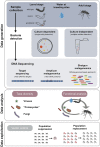Aedes spp. and Their Microbiota: A Review
- PMID: 31551973
- PMCID: PMC6738348
- DOI: 10.3389/fmicb.2019.02036
Aedes spp. and Their Microbiota: A Review
Abstract
Aedes spp. are a major public health concern due to their ability to be efficient vectors of dengue, Chikungunya, Zika, and other arboviruses. With limited vaccines available and no effective therapeutic treatments against arboviruses, the control of Aedes spp. populations is currently the only strategy to prevent disease transmission. Host-associated microbes (i.e., microbiota) recently emerged as a promising field to be explored for novel environmentally friendly vector control strategies. In particular, gut microbiota is revealing its impact on multiple aspects of Aedes spp. biology, including vector competence, thus being a promising target for manipulation. Here we describe the technological advances, which are currently expanding our understanding of microbiota composition, abundance, variability, and function in the two main arboviral vectors, the mosquitoes Aedes aegypti and Aedes albopictus. Aedes spp. microbiota is described in light of its tight connections with the environment, with which mosquitoes interact during their various developmental stages. Unraveling the dynamic interactions among the ecology of the habitat, the mosquito and the microbiota have the potential to uncover novel physiological interdependencies and provide a novel perspective for mosquito control.
Keywords: Aedes spp.; bacterial community; breeding sites; symbiosis; vector control.
Figures



References
Publication types
LinkOut - more resources
Full Text Sources
Miscellaneous

